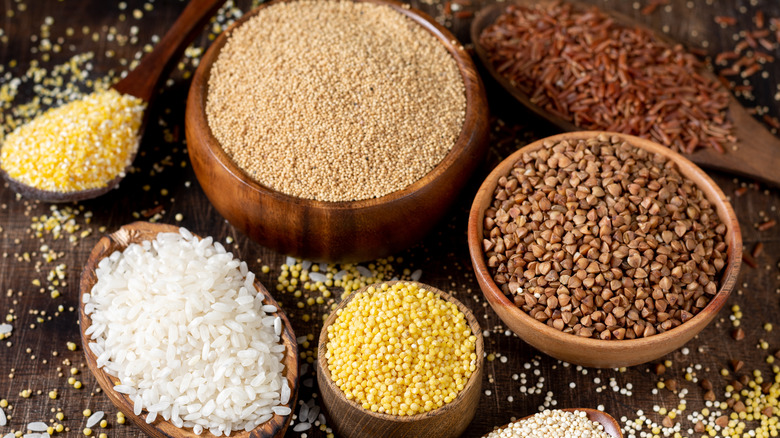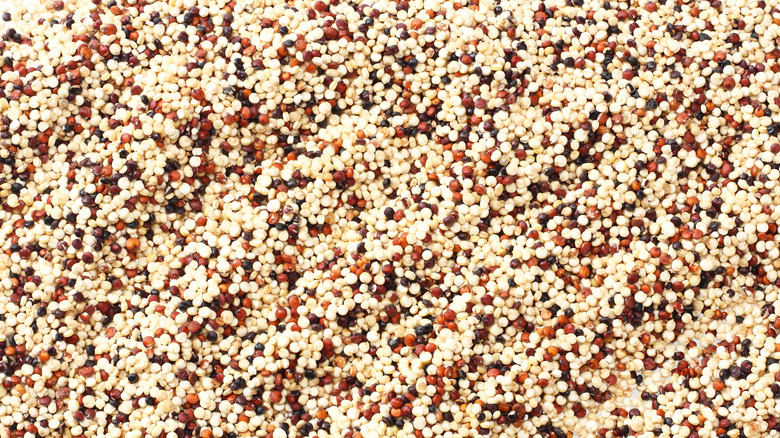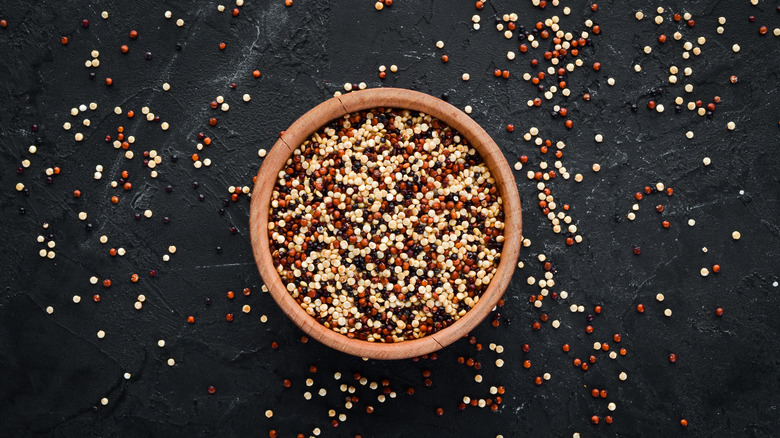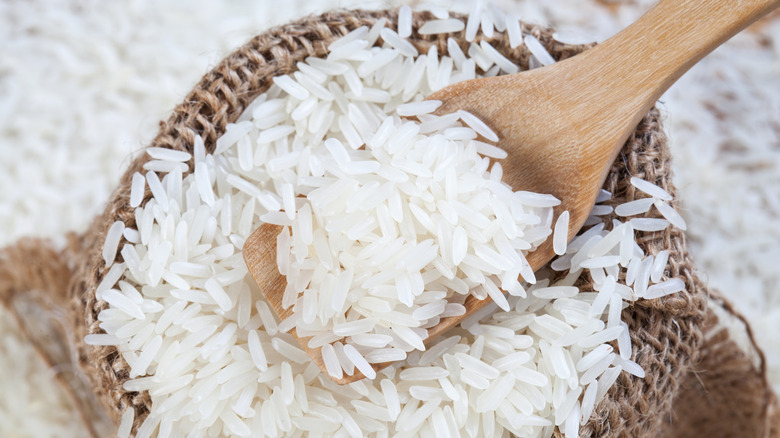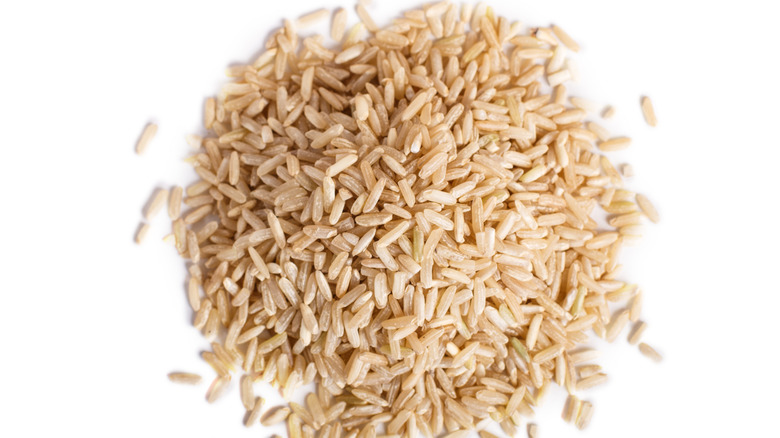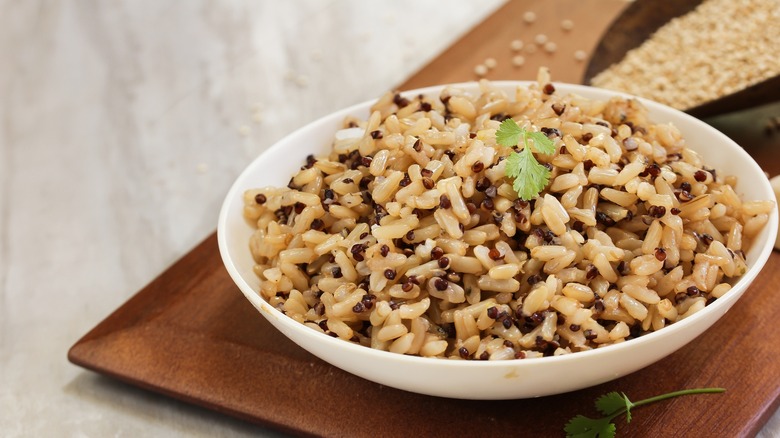Quinoa Vs. Rice: Which Is More Nutritious?
In the world of health foods, there is often tons of contradictory information. It usually comes down to one food not being better than another but rather certain foods being better for different people's dietary needs. Some foods tend to fit diets like keto or paleo better, while others are more well-suited to Whole360 or simply healthy, intuitive eating. Everyone's body is different, so naturally varying diets, ratios of macronutrients, and more work better for individuals.
That's why it is difficult to determine whether quinoa or rice is better for you, even though quinoa does have more nutritional value than an equal amount of rice. Quinoa offers more protein and fiber and has a lower glycemic index value than rice; however, both are gluten-free options (via My Recipes). Still, you can and should evaluate the nutritional values of each on your own and determine which is the best option for you specifically.
What is quinoa?
Quinoa tends to be rather misunderstood because it is usually thought of as a grain. But the superfood isn't a grain at all. It's actually a seed from the Chenopodium quinoa plant, which originally comes from the South American countries of Peru, Chile, and Bolivia (via Live Science). Now, the plants are grown in far more countries to help meet the demand for the food after it spiked in popularity as a health food.
The reason quinoa became such a popular health food is because of its amazing combination of nutrients. Not only is it a great source of protein and fiber, but it is loaded with healthy fats, antioxidants, vitamins, and minerals. Live Science writer Jessie Szalay spoke with Kelly Toups, a registered dietician for the Whole Grains Council, who said, "quinoa is a good source of protein, fiber, iron, copper, thiamin and vitamin B6." She additionally called it "an excellent source of magnesium, phosphorus, manganese and folate." The complete protein is clearly a great way to get a dose of so many of those important good-for-you nutrients.
What are the health benefits of quinoa?
According to Healthline, 185 grams of quinoa is about a one-cup serving. That means the nutrition facts for 100 grams of quinoa represent just slightly more than a half-cup serving. Therefore, a half-cup of quinoa has 120 calories, 4.4 grams of protein, 21.3 grams of carbs, and less than one gram of sugar. That serving size also has 2.8 grams of fiber and 1.9 grams of fat.
Apart from its nutritional value, quinoa has numerous health benefits, too. The seed can help with inflammation and digestion, but that's just the start. One of the best health benefits of eating quinoa is that it can help lower your cholesterol. When those with high cholesterol succeed at lowering it, they also improve their heart health. Quinoa is also a good choice for those looking to manage their diabetes. Clearly, quinoa is a great food to incorporate into your diet no matter what your health goals are.
What are the health benefits of white rice?
White rice is a more processed version of brown rice, according to UPMC. Essentially, the bran and germ are removed from the grain, which means that white rice is not a whole grain but a "refined grain" instead. Since removing parts of the whole grain also removes nutrients, white rice is often fortified to add some nutrients back in. Think of it like produce without the skin or peel. It simply doesn't have as many nutrients as eating the whole thing, which in this case would be brown rice (via LiveStrong).
The one positive of white rice is that it does have a fair amount of folic acid, which is great for those who are pregnant or breastfeeding. Folic acid is often a key nutrient in prenatal vitamins because it helps cells to divide and work to grow the embryo. Other added nutrients that white rice contains are calcium and iron. So even if the food isn't the absolute best option, it still has value and can be part of a healthy diet.
With regard to nutritional facts, 100 grams of enriched white rice has 123 calories, 2.9 grams of protein, 26 grams of carbs, less than half a gram of fat, and about one gram of fiber, according to Healthline.
What are the health benefits of brown rice?
Brown rice is the whole grain version of rice, which means it has superior nutritional value to white rice (via UPMC). Though quinoa is a seed, it shares many properties with whole grains, so quinoa and brown rice offer similar health benefits. Like quinoa, brown rice is great for lowering cholesterol, which improves heart health by lowering the risk of heart disease or stroke. Brown rice is also a great food to eat and keep on hand to manage diabetes because it is good for keeping blood sugar under control.
Brown rice has more protein and fiber than white rice, though it is also higher in calories than quinoa. But like quinoa, brown rice is also a good source of select minerals, like magnesium, as well as antioxidants and anti-inflammatory properties. As for nutrition, Healthline claims that one cup of brown rice packs 216 calories, 44 grams of carbs, 3.5 grams of fiber, 5 grams of protein, and 1.8 grams of fat.
Is quinoa better for you than rice?
If you are looking for the best food choice that packs the most overall nutrition, then quinoa is better for you than rice. White rice offers the least amount of nutritional value even though it is relatively low in calories. The argument of which option is healthiest is really between quinoa and brown rice.
According to My Recipes, both quinoa and brown rice have very similar nutritional facts with regard to calories, vitamins, and minerals. It's in the macronutrients (carbs, fat, and protein) that things are uneven between the seed and grain. Quinoa has more protein, fewer carbs, and more fat. So, if you are trying to increase fat or protein, then quinoa is the better choice. However, both are very healthy options and can be easily incorporated into a healthy diet. No matter which you opt for, you can feel good about what you're eating.
